Porcelain Insulator News
by Jack H. Tod
Reprinted from "INSULATORS - Crown Jewels of the Wire", October 1974, page 15
Preferably direct porcelain news items and questions directly to Jack H. Tod,
3427 N. 47th Place, Phoenix, Ariz. 85018. All mail will be answered if reply
stamp is enclosed, and the most newsworthy items and questions of general
interest will be published as space permits.
Dear Jack:
In the July 1974 issue of Insulators on page 19, Lew Hohn of Rochester, N.Y.
called U-217 and U-217A transposition insulators. These insulators are not
really transposition insulators, but they could be used as such. Communication
line transposition insulators are designed for low voltage. These insulators are
designed for moderately high voltage, as you will note that they have three
skirts between the bottom wire groove and the pin. These insulators were
designed for use on high voltage constant series street light circuits to break
the current at each lamp. Some of these circuits ran as high an 10,000 volts at
6.6 amperes.
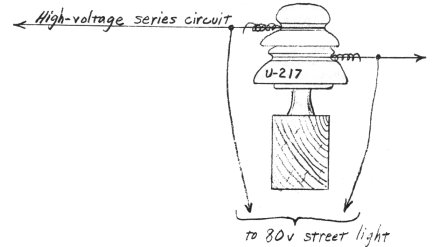
The city of Chicago used these insulators extensively several years ago when
they had series street lights.
I am attaching a sketch of how they were used on series lighting. In this use
it is not necessary to have much insulation between the wire grooves since the
voltage drop over the lamp is only about 80 volts. The high voltage occurs
between the series circuit and ground.
Frank Donnelly,
Electrical Engineer
Western Springs, Ill.
- - - - - - - - - -
Dear Frank:
I agree with you that designs such as the U-217 would be suitable for this
"break" application and have been used as such. Any similar two-groove
design with high enough voltage rating would do. We have some municipalities in
Arizona which use series-connected street lights, and all of these that use pin
types for the break use Hi-Tops such an U-784 just as in the sketch above.
I disagree with what you say about the communication type insulators. True,
voltage flashover considerations are out of the picture there, but it is highly
important on long lines to maintain a very long leakage path from line to
ground. You will note this on all common designs such as the Hemingray 42
(CD-154) which are used on long distance communications lines.
I really can't disagree with your statement about these insulators (U-217
etc.) being "designed for" these high voltage applications instead of
just used for that because they were suited for it. These designs originated in
1910 or earlier. I have factory drawings of most of these insulator styles plus
the various company catalogs describing them to potential customers, but I do
not have any engineering notes shedding light on the designer's thoughts at the
time the designs were created. I suspect you don't have any of that data either.
We continue to list these designs an transpositions because (1) the large
leakage path to ground is not incompatible with the design requirements of long
distance phone lines and, (2) all of these designs were listed in the porcelain
company catalogs as "Transpositions". Here are some examples of the
catalog listings:
Locke, Sheet 2950, 8-15-10: "TELEPHONE TRANSPOSITION -- This insulator (No.
2114, which is U-212) provides, between the telephone line and ground, as much
insulation as ordinarily provided for 15000 volt operation."
Cook, 1929 catalog, page 11A: "Nos. 1156 (U-205), 1449 (U-210) and 378
U-213) are respectively light, medium and heavy transposition types possessing
the most desirable electrical and mechanical characteristics."
Locke 1916 catalog, page 118: "No. 2817 Transposition." (This one
is U-217A.)
Canadian Porcelain Co., Cat. 401, page 29: "Insulator No. 450 -- Telephone Transposition." (This is U-217A.)
Lapp, Cat. #5, 1931, page 85: "Nos. 588A (U-780) and 6277 (U-215) are
transposition insulators: No. 588A is suitable for line potentials up to 8000
volts to ground and 200 volts between grooves. No. 6277 is suitable for line
potentials up to 8000 volts to ground and 2200 volts between grooves."
Note the Lapp 1931 catalog comments and which seems to stress use of these in
applications such as series street light circuits. Nevertheless, they use the
term "Transposition" for them. They probably goofed it here though, as
I am sure the U-780 was never meant to be and was never used as a telephone
transposition, and I do believe it was specifically designed for the series
circuit break application as you describe. We list it in with the side-tie
Hi-Tops in the style chart for lack of a better spot for it
Porcelain company catalogers were grossly uninformed or misinformed about the
use of the insulators by their customers on the actual lines and were prone to
err in their catalog descriptions. Pinco even listed their two-groove ponies
incorrectly as "Telephone Transpositions" just because they didn't
know any better, and there are many other examples of incorrectly labeled styles
in catalogs.
So there you go. All the porcelain companies could have mislabeled these in
catalogs since 1910, or maybe the true name utilities used for these on the
street lamp circuits were "transposition insulators" instead of
"break insulators". On the other hand, look at that nice long leakage
path between the grooves provided by the drip-pointed skirt between them -- the
ideal design for phone line transpositions.
All these facts considered, I still say "a transposition is a
transposition is a transposition is a ..."
Jack Tod,
Electrical Engineer
Dear Jack: (July 2, 1974)
... Have enclosed a rough drawing of an insulator dug by John DeVolder in a dump.
It's in two pieces, but they fit together enough to make the drawing. A real
wierdo. No sign of a part that would screw on top.
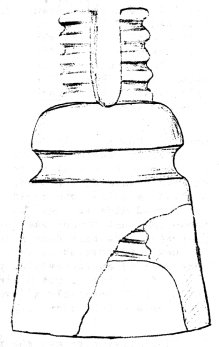
... And last but by no means least. Had a call from Mrs. Barlow after the article
in C.J. (July, pages 20-21) on the copper lustre item, and offering my money
back if I was doubtful of its authenticity, but I reassured her I was satisfied.
A collector friend of theirs (& neighbor) took 6 from a line in western
Pa, One was broken beyond repair, so there are only these five.
Mrs. Barlow has one, Bill Cosner, Dr. Schoenthal and myself. They're not
painted on - it's a fired authentic copper lustre, same as you'll see on old
china.
Lew Hohn,
Rochester, N.Y.
- - - - - - - - - -
Dear Lew: (July 5, 1974)
The insulator DeVolder found is really exciting, but you can tell him he's a
kill-joy for not digging until he found the top part! I have over 100 file cards
on various patented pin types for "no tie wires" for the 30-year
period 1890-1919. Of these, 29 are for types with caps that screw onto a
threaded top like your drawing. At least 3 or 4 of these would possibly fit your
item, and the most probable of these is #726,846 of May 5, 1903 by Joseph R.
Bell, Peckville, Pa.
In my July answer on the copper lustre items, I said I'd be a believer if
these were found on actual lines. (Just to show that it occasionally pays to be
a skeptic when things seem illogical, note the following two letters tracking
down the origin of these items.)
Jack
Dear Mr. (Roy) Licari: (July 25, 1974)
I recently purchased from Mrs. Barlow's daughter a small pony insulator with
copper lustre glaze. I mentioned it to Tod in a letter, and he put a rather
cryptic answer in Crown Jewels (July 1974, page 21). I promptly wrote, assured
him of its authenticity and source (Mrs. Barlow) and other info concerning
copper lustre I'm sure he was unaware of. He wrote back that my points were well
taken & would publish all info concerning them. Mrs. Barlow wrote that she
obtained hers & her daughter's from you, and you could possibly tell me (1)
where they were found? (2) How used? 3) What lines? 4) She thought 5 total plus
one broken one.
I have enclosed a SASE and would appreciate any information you may have. I
shall in turn write to Jack Tod who will publish it in Crown Jewels column .
Thanks for your time and trouble.
Lew Hohn
- - - - - - - - - -
Dear Mr. Hohn: (July 29, 1974)
I don't know much about these insulators. Got them at a flea market several
years ago, along with others. From the appearance of the base, I would say the
lustre was applied as a last stage, after the firing originally.
Showed mine to Jack Tod at Ithaca show in 1972, and he commented that copper
was not an insulator, and that someone [may have] had them done along with the
baby's shoes.
Don't believe these were ever used on lines, but rather done by a telephone-related party as ornaments or gifts.
As for total, I got 6, including one damaged. If above theory is OK, possibly
a dozen or two were made & scattered, with these 6 left over ....
Roy Licari
"Just trying to get the facts, mam. All we need are the facts, mam."
We won't take space for more information on these items unless the seller at the
flea market cares to carry it back a notch further.
Jack
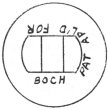
Dear Jack:
I bought a U-928 at the N.I.A. National show, and it's unlike any that I have
seen. It is embossed (raised letters) BOCH PAT APL'D FOR on the shell below the
side groove and is an unusually crude glazeweld for Thomas. The heavy glaze has
covered much of the embossing making it hard to read, and there might be
something else just after the word BOCH. Any comments would be appreciated.
Mike Barbieri,
N.Y.
- - - - - - - - -
Dear Mike:
A tremendous find. An early classic undoubtedly made by Thomas
between the 10-23-97 patent filing date and the 3-8-98 granting date, after
which they used the hand-stamp log with the 1898 date. Note question #24 of
August QUIZ. This makes the second known embossed wet process pin type. Anyone
else have this one?
Jack
Dear Jack:
... Might note I now have four different U-293B, all in white and all identical
shape, but marked as follows: (1) Unmarked, (2) B & O, (3) PP, (4) FINDLAY
180-1.
Read your company histories in Crown Jewels. I feel this information to be of
great importance to collectors. Historical impartments greatly enchants any
specimen. Keep up the great work.
Also, I feel there is a great need for drawings, information (in fact, a
book) on the old 2 and 3-piece multis, and I believe most serious collectors
feel this need. Any information is helpful. Could you crowd in a little in Crown
Jewels as available?
R.L. Perkins,
Hillsboro, Ill.
- - - - - - - - -
Dear Robert:
Your info on the U-293B is great, and I'll buy it that the B & O items
were made by Findlay (PP after 1927). it is difficult to attribute some of these
customer markings to manufacturers, so each one we can tag is a real victory.
Thanks for your encouragement on the "histories" in the column.
These fullblown writeups on various companies are also augmented by my
loquacious answers to simple questions about "whatisit" and
"whodunit".
I and all others agree with you about the desirability for more info on the
old multis. It was just a situation when I researched my book that I had to draw
the line somewhere, and even the "uniparts" were a monumental chore
themselves. I did at least put in all the glazewelds by the simple expedient of
arbitrarily defining "uniparts" as "Fired in one piece and not
having parts cemented together."
When I started my research, I planned three volumes to publish the results,
one of which was the one on unipart pin types published in 1971.
The second was to be on nominally "standard porcelain" (and related dry
press insulators). I have fair to rather complete histories on 97 companies
involved, bulging files of data on patents, company markings, etc.
The third volume was to cover all other forms of line insulators other than
the unipart pin types, and that naturally would have had a section on the
multiparts.
It is doubtful that these second and third volumes can ever be published. The
first volume on unipart pin types is capable of recouping the printing costs,
but the other two would both be financial negatives of considerable magnitude.
One of the biggest reasons for this is the soaring inflation of the past few
years and at present. Here are some examples (from Indicator Digest) of why the
1940 dollar you spent on hobby books will now buy only 19 cents.
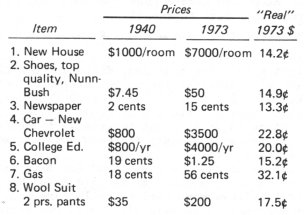
So, while you now pay $4 for the $.50 haircut of 1940, should you expect the
old $2.50 best seller to still be $2.50 -- or the old $12.50 specialized
reference book to still be $12.50? Yes, you do! Sorry, but it just can't be.
That specialized reference book should now be $60 to match the inflated price on
all other things.
You must realize that it is impossible to compare individual copy costs of a
specialized hobby book appealing to only a couple of hundred people (or less)
with a book such as "Arnold Palmer on Golf" which sells hundreds of
thousands of copies the first printing. Just an an illustrative example, suppose
that for either the Golf book or the Insulator book, the setup charges to get
all plates made and the first book printed were skimped down to $6,000 and that
each copy thereafter would have a printing and binding cost of $1.50 each.
Now, spreading that $5,000 initial cost over as few as 100,00 of the Golf
books comes to 50 per book, making the total cost of printing the Golf book
$1.55 per copy.
Spreading the $5,000 setup over the 200 Insulator books adds $25 to each
copy, so their total printing cost comes to $26.50 each.
On the other hand, assume that as many as 1,000 of the specialized Insulator
book could be sold, the setup charge would dwindle to only $5 per copy, making
the total cost only $6.50 per copy.
I estimate the maximum sales (at any price) of such specialized insulator
books would be 200 copies, and it could be considerably less than that. The only
way we could ever get the book is for all 200 of us to chip in $25 share -- and
you just know that isn't about to happen!
Collectors will spend thousands of dollars on insulator specimens and traveling
around the show circuit, or even $7.62 for that Halibut Steak with
Shrimp Sauce at the Hershey show, but they just can't bring themselves to pay $5
to $20 for a good reference book that will stick with them a lot longer than
that Halibut Steak. This in not unique to insulator collectors; it's true in all
other hobbies that I've been involved in.
Researchers are generally willing to contribute all their considerable effort
and publish their data for the benefit of others in the hobby, and for their
personal satisfaction to properly record their work, but should all collectors
who will benefit from the books expect the authors to subsidize a large portion
of the publication costs? As costs continue to rise, I feel most authors (take
note, Gene Bond) will think twice about publishing their data just to satisfy
their ego at the expense of their pocketbook.
I have taken space to expound on this subject because I have received
possibly over one hundred questions in the past three years on why this and that
isn't published by me or someone else. I simply get tired of writing back the
same answer every week or so, and this should explain the situation adequately.
Since publishing the specialized books has become a financial
impracticability, I do the best I can by disseminating my unpublished research
data through this column, and fortunately for me, Dora pays that printer!
In direct answer to your question about multipart pin types, yes we will try
to squeeze in more and more info on multis and other neglected insulator types
in the future. New information on pin types and other smaller insulators came so
fast and furious in the past two years, we have had a column space problem. In
fairness to glass insulator reporting, I arbitrarily have limited the column to
eight pages monthly -- occasionally sneaking in an extra page or two.
Meanwhile, if you didn't make it to Hershey show, you can use the $7.62 you
saved on the Halibut to buy Gerald Brown's "Second Edition" which has
additional information on multi's and still have $1.62 left over to buy a
hamburger and shake, which cost a total of $.35 in 1940.
Jack
DRY PROCESS PORCELAIN MARKINGS
Hopefully, the following explanation about how and why markings are applied
to dry press porcelain dies in different manners will answer a number of
questions. The photo of the FINDLAY cleats shows the two marking types.
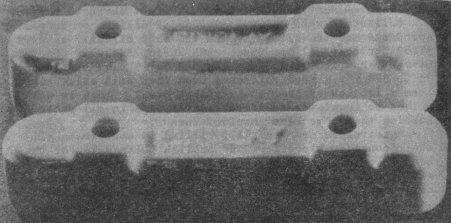
The bottom cleat has "embossed" letters, just as you see on glass
pin type insulators. The top cleat has a "recess- embossed" marking.
Shown in the photo at the right are the ways each of these markings are made
in the dies. (I used the MACOMB marking since each letter in this marking can be
made without the use of "reverse" letter punch which I don't have.)
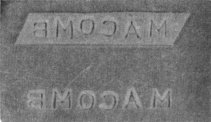
In the "embossed" marking (bottom one), the letters are punched
directly into the surface of the insulator die, and the marking appears as on
the bottom Findlay cleat.
In the "recess-embossed" marking the letters are punched into a
piece of brass sheet stock which is then cut out around the marking and
soft-soldered onto the surface of the die. If very thin brass stock is used as
on my top MACOMB example, the recessing is slight. Thick brass stock results in
deeply recessed markings as with the top FINDLAY cleat.
The embossed marking, just as on molds for glass insulators, has the
disadvantage that it is difficult to change. It requires that the old marking be
completely brazed over and the new marking punched in over the repaired area. On
the other hand, the recess-embossed marking can be easily changed by merely
heating and removing the soldered-on brass marking plate and adding a revised
one.
No set rules can be stated for the use of either type of marking, but some
generalizations may be made which do help in solving puzzles about attribution
of some markings.
First, due to the relative permanency of the embossed markings on the dies,
they were used mostly on dies where changes were not required; that is, on dies
for standard porcelain items to be sold as proprietary item by the porcelain
company involved and on special dies owned by individual customers who had
various porcelain companies make their items for them under contract. Secondly,
the recess-embossed markings were usually always used on items made on contract
for individual customers with their markings where the porcelain company owned
the dies, and this type of marking was always used when porcelain companies
added their own marking on dies owned by and furnished by the customer on
contract orders.
As examples. Suppose Illinois made rack spools as a proprietary catalog item;
these could be marked with the "ILLINOIS" marking in embossed
characters (permanently on the dies). But suppose Joslyn wanted a small order of
10,000 spools with their name on it and made with Illinois dies; the JOSLYN name
would be added to the die with the recess-embossed marking method and removed
after the run.
But suppose Joslyn owned their own dies. These could have the name "JOSLYN"
permanently stamped into the dies. With Joslyn's permission on the order,
Illinois could also add their Illinois mark by the recess-embossed method to
make the run and then remove this marking strip after the run without any damage
to JosyIn's die sets.
There are a number of exceptions to these generalizations regarding
recess-embossed markings. Many companies had the habit of using
recessed-embossed markings on even standard porcelain and proprietary items for
various reasons - to avoid having the marking abrade the wires or mating
surface, to protect the marking from chipping, to provide the maximum
flexibility for possible marking changes on the dies in the future, etc.
Just as on any markings applied directly to a die or mold, every specimen
made from that die will have identical markings. The number of different
"die sets" as evidenced by the different orientation of the marking
characters on specimens is some evidence of the magnitude of production of that
item by the porcelain company over a period of time
Needless to say, either marking type requires "reverse" (mirror image)
letter punches to make. Many companies were rather careless in making the dies,
and use of regular letter and number punches for some characters results in many
backward character "errors" on dry press markings.
Recess-embossed markings do not occur on glass insulator for the simple
reason that the high temperature of the molten glass causes the molds to operate
above the melting point of ordinary solder used for attaching the markers.
| 